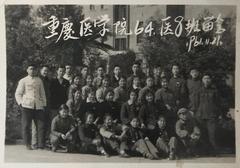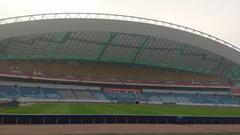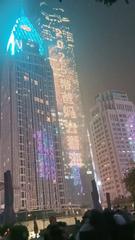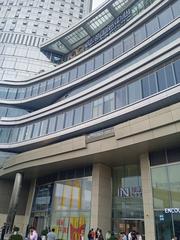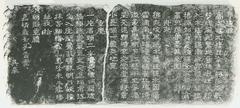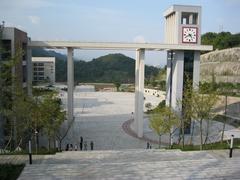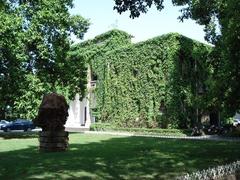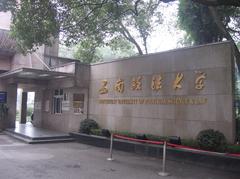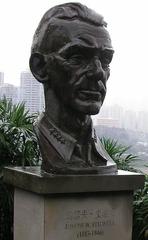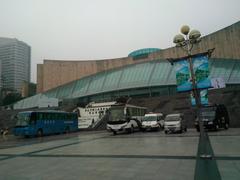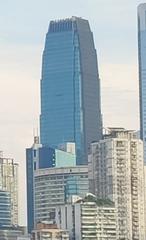
Baijusi Station Visiting Hours, Tickets, and Chongqing Historical Sites Guide
Date: 04/07/2025
Introduction to Baijusi Station and Its Significance
Baijusi Station, situated in the dynamic city of Chongqing, China, functions as a crucial gateway connecting visitors to the city’s rich historical heritage and contemporary urban development. Launched in 2014 as part of the Chongqing Rail Transit (CRT) Line 2 expansion and subsequently integrated with Line 18, Baijusi Station is now a pivotal interchange exemplifying Chongqing’s innovative transit solutions for its mountainous landscape (Wikipedia; The China Journey).
Located in Dadukou District, an area known for its industrial history, Baijusi Station not only streamlines transportation but also represents the district’s evolution from a steel manufacturing center to a vibrant, mixed-use urban area. This transformation is underscored by the adjacent Baijusi Yangtze River Bridge, recognized as the world’s largest span dual-layer steel truss cable-stayed bridge, which significantly enhances southern Chongqing’s connectivity (People’s Daily; China Daily).
Baijusi Station also provides easy access to a range of cultural and historical sites, including the tranquil Baijusi Temple in Nan’an District, the lively Hongya Cave, and the iconic Liziba Monorail Station. Travelers can experience Chongqing’s unique “Mountain City” charm and urban ingenuity through these attractions (ArchinaTour; Travel China Tips).
This comprehensive guide details Baijusi Station’s visiting hours, ticketing, accessibility, connection to other transport modes, as well as nearby attractions and travel tips. Whether you are a commuter, tourist, or history buff, this resource will help you fully appreciate Baijusi Station’s role as a transport hub and cultural gateway in Chongqing.
Table of Contents
- Introduction
- Historical Development of Baijusi Station
- Urban Significance of Baijusi Station
- Practical Visitor Information for Baijusi Station
- Nearby Attractions and Experiences
- Baijusi Temple Overview
- Baijusi Yangtze River Bridge Details
- Navigating Baijusi Station and Surrounding Areas
- Exploring Chongqing Historical Sites Near Baijusi Station
- Local Culture and Culinary Highlights
- Safety, Connectivity, and Visitor Services
- FAQ Section
- Conclusion and Call to Action
Historical Development of Baijusi Station
Origins and Opening
Baijusi Station plays a vital role in Chongqing’s CRT network. Located in Dadukou District, it opened in 2014 as part of Line 2’s expansion and later became an interchange with Line 18 (Wikipedia). This development enhanced connectivity between Chongqing’s industrial base and emerging residential areas.
Integration into Chongqing’s Urban Rail System
Chongqing’s challenging terrain has led to innovative transport solutions, including a combination of metro and monorail lines (The China Journey). Baijusi Station’s inclusion on Line 2, a core light rail route, and its integration with the newer Line 18 reinforce its importance as a major transfer hub. This aligns with Chongqing’s strategic goal to operate 18 metro lines by 2050, covering over 820 kilometers (Travel China Tips).
Urban Renewal and Industrial Heritage
Dadukou District’s heritage as a steel industry center has shaped its character. The arrival of Baijusi Station has accelerated urban renewal, supporting the district’s shift toward a mixed-use community with better amenities and public spaces (ArchinaTour). This reflects Chongqing’s broader urban planning ethos, which balances preservation of industrial history and contemporary development.
Urban Significance of Baijusi Station
Strategic Location and Connectivity
Positioned at the intersection of Dadukou and Banan districts, Baijusi Station is strategically located for both commuters and visitors. The completion of the Baijusi Yangtze River Bridge—a groundbreaking structure supporting both rail and road—has further enhanced regional access and economic integration (People’s Daily).
Role in Chongqing’s “Mountain City” Identity
Baijusi Station’s design and positioning exemplify Chongqing’s “Mountain City” spirit, integrating urban infrastructure with steep hills and river valleys (The China Journey; ArchinaTour). It offers panoramic views and serves as a launch point for exploring the city’s iconic bridges and riverscapes.
Economic and Social Impact
Baijusi Station has catalyzed local economic development, attracting businesses and new residents while revitalizing Dadukou District (Travel China Tips). Enhanced transit access also improves connections to jobs, education, and healthcare, supporting social cohesion and mobility.
Practical Visitor Information for Baijusi Station
Visiting Hours
Baijusi Station follows the CRT schedule, operating from 6:00 AM to 10:30 PM daily.
Ticketing Information
Tickets can be purchased at station kiosks using cash, cards, or mobile payments (Alipay/WeChat Pay). Options include:
- Single-ride tickets (¥2–¥10 depending on distance)
- Chongqing Transportation Card (rechargeable, suitable for frequent use)
Tourists are encouraged to use a transportation card for convenience (Travel China Tips).
Accessibility Features
The station provides barrier-free access, elevators, tactile paving, and accessible restrooms. Staff are available to assist travelers with disabilities.
Connectivity to Other Transport Modes
Integrated with the Baijusi Yangtze River Bridge, the station allows seamless transfer to road transport, taxis, buses, and ride-hailing services (People’s Daily).
Nearby Attractions and Experiences
Baijusi Yangtze River Bridge
A visual and engineering highlight, the bridge offers panoramic views and is a favorite for photography enthusiasts.
Historic and Cultural Sites
From Baijusi Station, visitors can explore:
- Hongya Cave: Traditional stilt houses with shops and restaurants
- Liziba Monorail Station: Monorail track passes through a residential building
- Jiefangbei CBD: Central commercial area
Guided Tours and Special Events
Guided tours in Dadukou District cover local industrial heritage and urban renewal, providing historical context and unique insights.
Baijusi Temple Overview
Baijusi Temple (白居寺), located in Nan’an District, is a significant Buddhist monument renowned for its serene setting and classical architecture. The temple houses multiple halls, ancient inscriptions, and statues, reflecting centuries of spiritual and artistic tradition.
Visiting Hours: 8:00 AM–6:00 PM daily
Tickets: CNY 20 for adults; discounts for students, seniors, and children.
Facilities: Restrooms, visitor center, souvenir shops, accessible paths
Location: Easily accessible via CRT Baijusi Station (Line 3 or 10) and local bus routes; taxi and ride-hailing options available.
Nearby Attractions: Jiefangbei CBD, Hongya Cave, Yangtze River Cableway
Special Events: Hosts festivals like Chinese New Year and the Lantern Festival with ceremonies and performances.
Photography: Allowed in most areas; restrictions may apply in sacred spaces.
Baijusi Yangtze River Bridge Details
Engineering Marvel: The bridge spans 1,384 meters, with a main span of 660 meters, dual layers for road and rail, and towers reaching 236 meters (China Daily).
Design: Inspired by water droplets, the bridge’s white towers and illuminated lines blend with the riverside landscape.
Function: Upper deck for expressway traffic; lower deck for CRT Line 18.
Accessibility: Wide pedestrian pathways and observation points, accessible by CRT Line 18 (Baijusi Station).
Visiting Hours: 6:00 AM–10:00 PM; free pedestrian access; metro ticketing applies for rail transit.
Navigating Baijusi Station and Surrounding Areas
- Metro: Trains every 3–7 minutes during peak hours
- Bike Sharing: Available; some basic Chinese helpful
- Taxis/Ride-Hailing: Didi app recommended
- Buses: Routes posted in Chinese; digital maps assist navigation
Walking: Prepare for hills and stairs; comfortable footwear is recommended
Weather: Spring (March–May) and autumn (September–November) offer the best conditions
Exploring Chongqing Historical Sites Near Baijusi Station
- Hongya Cave: Night visits recommended for cityscape views
- Ciqikou Ancient Town: Accessible by metro; rich in history and street food
- Yangtze River Cableway: Offers panoramic city views; operates 8:00 AM–10:00 PM (March–November)
Local Culture and Culinary Highlights
Discover Chongqing’s Bayu heritage through local dialects, street life, and cuisine. Don’t miss spicy hot pot, Chongqing noodles, and street snacks near Baijusi Station.
Safety, Connectivity, and Visitor Services
- Safety: Chongqing is generally safe; remain vigilant in crowded places
- Connectivity: Free Wi-Fi in stations/restaurants; local SIM/eSIM recommended
- Emergency: 24-hour tourist hotline: +86-23-96096
- Luggage Storage: Available in major metro stations
FAQs
Q1: What are Baijusi Station’s operating hours?
A1: 6:00 AM to 10:30 PM daily
Q2: How can I buy metro tickets?
A2: At kiosks, via the metro app, or with Alipay/WeChat Pay
Q3: Is the Baijusi Yangtze River Bridge free to visit?
A3: Yes, public viewing areas are free; guided tours may require a fee
Q4: Is Baijusi Station accessible for disabled visitors?
A4: Yes, with elevators, tactile paving, and staff assistance
Q5: When is the best time to visit Chongqing?
A5: Spring and autumn for pleasant weather
Conclusion and Call to Action
Baijusi Station embodies Chongqing’s merger of tradition and modernity. It provides seamless connections to historical sites, engineering marvels, and vibrant local life. Whether you seek culture, architecture, or culinary adventures, Baijusi Station is your ideal starting point.
For current updates on schedules, events, and attractions, download the Audiala app and follow us on social media for real-time tips and exclusive travel content!
Suggested Visuals
- Baijusi Station exterior: Alt text: “Baijusi Station entrance in Chongqing metro system”
- Baijusi Yangtze River Bridge at night: Alt text: “Baijusi Yangtze River Bridge lit up at night with colorful lights”
- Chongqing street food scene: Alt text: “Local Chongqing street food near Baijusi Station”
- Map of area: Alt text: “Map of Baijusi Station area and Chongqing historical sites”
Internal Linking Suggestions
- “Chongqing Metro System Guide”
- “Top Historical Sites in Chongqing”
- “Chongqing Local Cuisine: A Food Lover’s Guide”
References and Official Sources for Baijusi Station
- Baijusi Station, 2024, Wikipedia
- Chongqing’s Mountain City Transit, 2023, The China Journey
- Baijusi Yangtze River Bridge Opens, 2025, People’s Daily
- Chongqing Urban Scenery and Architecture, 2024, ArchinaTour
- Chongqing Metro FAQ 2025, 2025, Travel China Tips
- Baijusi Yangtze River Bridge, 2024, China Daily
- Trip.com Metro Guide
- Trip.com Transport Guide
- TravelChina Tips - Chongqing Culture and Attractions



